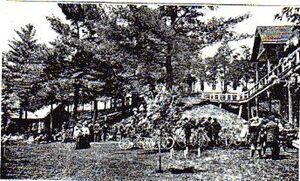Cartersburg Springs facts for kids
Cartersburg Springs (also known as Magnetic Springs) is a special place in Liberty Township, Hendricks County, Indiana. It's about a mile north of the town of Cartersburg. This site was once famous for its natural springs, but they have now stopped flowing.
Contents
Where are Cartersburg Springs?
Cartersburg Springs is located at 39°42′32″N 86°28′23″W / 39.709002°N 86.473002°W. This spot is in the state of Indiana, in the United States.
History of Cartersburg Springs
Early Days and Native Americans
Long before European settlers arrived, Native Americans knew about and used these springs. They visited the area often. Even as recently as the 1950s, people found old Native American items like arrowheads and beads near the springs.
The McCormick Family and "Healing Water"
Around 1800, the first white settlers, Samuel McCormick and his wife, moved to the hill overlooking the springs. They raised 12 children there. According to their daughter, Eliza Jane McCormick, no one in their family ever needed a doctor. They believed their good health came from drinking the spring water, which they thought had special healing powers.
By the mid-1800s, many local people would visit the springs. They would bathe in the water and take containers of it home. They also believed it was a "miracle water."
A Dream of a Resort
In 1822, a group of people bought the land around the springs. By the late 1800s, the springs were very popular for picnics and social events. A group of businessmen then formed the Cartersburg Springs Mineral Corporation. They wanted to sell shares and build a big resort.
A newspaper article from 1874 mentioned a meeting to create a top-notch hotel at the mineral springs. Important people were interested in the project. However, soon after, disagreements started among the group.
By 1900, the group had spent a lot of money and had to sell some of their land. One of the investors, Albert Veatch, bought about 70 acres, including the hill above the springs. He hoped to build his own hotel, but it never happened.
The Hotel Era
In 1901, an advertisement promoted the springs under new management. It said the hotel and bathhouse had been fixed up. It promised a nice place for health and a pleasant summer home. Prices included:
- Weekly stay: $7.00 or $8.00
- Daily stay: $1.50
- Single meals: $0.40
- Bath with help: $0.50
Around 1903, Dr. Kimberlin, a heart specialist, bought the Cartersburg Springs Mineral Corporation. He then sold part of it to Armand Koehne. Together, they made the resort a big success as a summer hotel.
A 1903 report from the Indiana State Board of Health said the spring water was "very pure and soft." It also said the water could help with problems like rheumatism, bladder, and kidney issues. It was also considered great drinking water.
By the summer of 1904, with Lee Allison as the hotel manager, the resort became very popular. Wealthy families would send their children, nannies, and nurses to stay for the whole summer. Parents would join them on weekends. Every room was full from June to August. In 1905 and 1906, people made reservations far in advance.
Besides the springs, the resort area had a dance hall, a bowling alley, a racetrack, and picnic grounds. The hotel was doing very well, and the area was thriving.
The Fire and Aftermath
After the 1906 season ended, Mr. Allison moved his things and planned new additions for the hotel. But one fall night, a fire broke out at the back of the hotel. It quickly spread to the bathhouse. People from all around tried to help, but everything was lost.
Neither the hotel nor the bathhouse was rebuilt. Some say it was because the two partners couldn't agree on what to build next. There were also rumors about the fire's cause, but no one ever proved it was set on purpose.
Despite the resort's end, the springs later became a source of income again. A company called Cartersburg-Crystal Springs Inc. started bottling the water. They built a collection plant at the springs. Water was then trucked to Indianapolis for processing and bottling. Cartersburg-Crystal Spring water was sold in many hotels and restaurants in Indianapolis. It was also delivered to homes.
Cartersburg-Crystal Springs Inc. operated for over 50 years.
The springs, which once produced more than 3,000 gallons of water every day, have now stopped flowing. The old collection plant at the springs is now part of a house, but you can still see the original building today.
Images for kids





